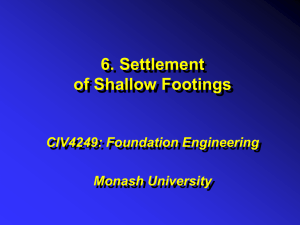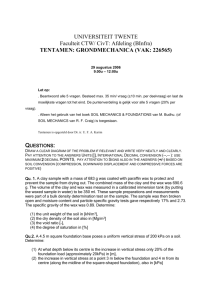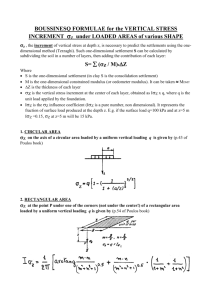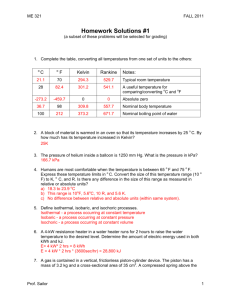CE 366 – SETTLEMENT (Problems & Solutions)
advertisement
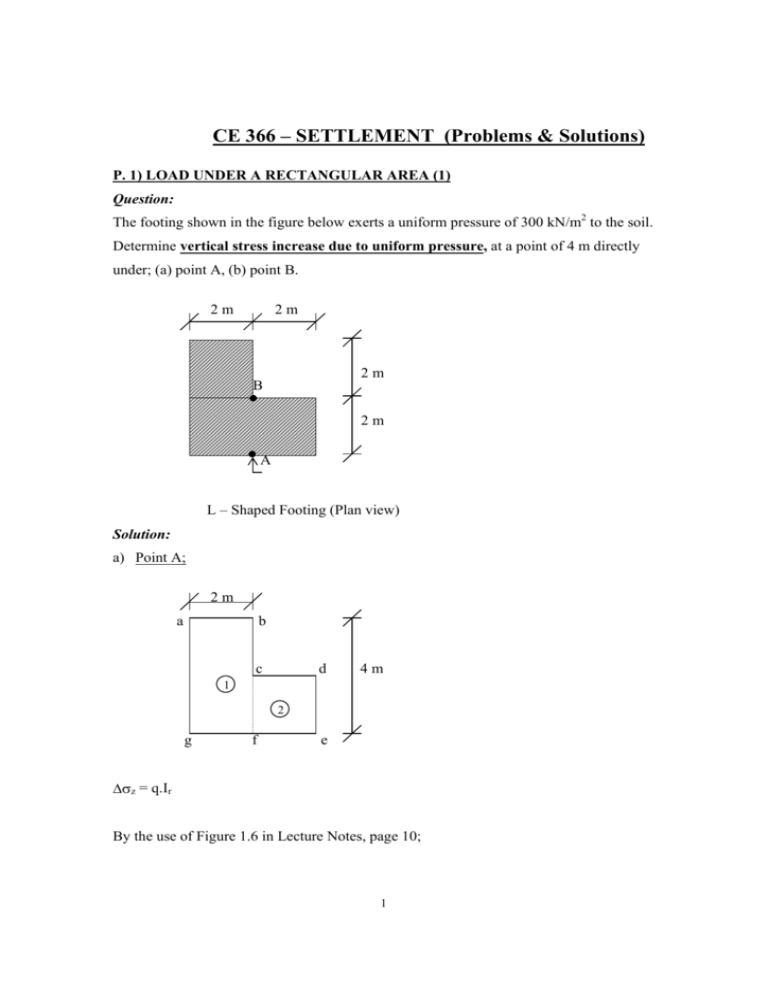
CE 366 – SETTLEMENT (Problems & Solutions) P. 1) LOAD UNDER A RECTANGULAR AREA (1) Question: The footing shown in the figure below exerts a uniform pressure of 300 kN/m2 to the soil. Determine vertical stress increase due to uniform pressure, at a point of 4 m directly under; (a) point A, (b) point B. 2m 2m 2m B 2m A L – Shaped Footing (Plan view) Solution: a) Point A; 2m a b c d 4m 1 2 g f e z = q.Ir By the use of Figure 1.6 in Lecture Notes, page 10; 1 For area 1 : A(abcfg) z=4m mz = 4 m = 4/4 = 1 nz = 2 n = 2/4 = 0.5 Ir = 0.12 For area 2 : A(cdef) z=4m mz = 2 m = 2/4 = 0.5 nz = 2 n = 2/4 = 0.5 Ir = 0.085 z = 300 (0.12 + 0.085) = 61.5 kPa the stress at 4 m depth under point A due to 300 kN/m2 uniform pressure b) Point B; 2m 1 2 B 2m 3 Area 1 = Area 2 = Area 3 mz = nz = 2 m = n = 2/4 = 0.5 Ir = 0.085 z = 300 (3 x 0.085) = 76.5 kPa the additional stress at 4 m depth under point B due to 300 kPa uniform pressure 2 P. 2) LOAD UNDER A RECTANGULAR AREA (2) Question: A rectangular footing as shown in figure below exerts a uniform pressure of 420 kN/m2. Determine the vertical stress due to uniform pressure at point A for a depth of 3 m. 6m A uniform pressure of 420 kN/m2 2m 2 5m Composite footing m A Plan View Solution: 2m 2m 2m b a 1.5 m c i j m k 2m h 1.5 m g f d e For area (abkh) : z=3m mz = 4 nz = 3.5 m = 4 / 3 = 1.33 n = 3.5 / 3 = 1.17 Ir = 0.195 m = 3.5 / 3 = 1.17 n = 2 / 3 = 0.67 Ir = 0.151 m = 2 / 3 = 0.67 n = 1.5 / 3 = 0.5 Ir = 0.105 For area (bcdk) : mz = 3.5 nz = 2 For area (defk) : mz = 2 nz = 1.5 3 For area (fghk) : mz = 4 nz = 1.5 m = 4 / 3 = 1.33 n = 1.5 / 3 = 0.5 Ir = 0.133 For area (ijkm) : mz = nz = 2 m = n = 2 / 3 = 0.67 Ir = 0.117 z = I r = 420 [ Ir 1 + Ir 2 + Ir 3 + Ir 4 - Ir 5 ] = 420 [ 0.195 + 0.151 + 0.105 + 0.133 – 0.117 ] z = 196.14 kPa Note: Where do we use the vertical stress increase, z , values? For example, in a consolidation settlement problem, stress increase, z, values are needed to calculate settlement under a foundation loading. We make the following calculations for a point located under the foundation at a certain depth (for example, at the mid-depth of the compressible layer): (1) First, calculate the initial effective vertical stress, ’v,o , before the building was constructed, (2) Then, find the vertical stress increase z at that depth, by using Boussinesq stress distribution or by approximate methods (for example 2V: 1H approximation) (3) Find the final effective vertical stress, ’v,f = ’v,o + z , after the building is constructed. (4) Use these values in calculating the settlement under the foundation. 4 P. 3) IMMEDIATE SETTLEMENT Question: A foundation 4 m 2 m, carrying a net uniform pressure of 200 kN/m2, is located at a depth of 1.5 m in a layer of clay 5 m thick for which the value of Eu is 45 MN/m2. The layer is underlain by a second layer, 10 m thick, for which the value of Eu is 80 MN/m2. A hard stratum lies below the second layer. Ground water table is at the depth of foundation. Determine the average immediate settlement under the foundation. Hint: Since soil is SATURATED CLAY, =0.5. So the following equation can be used: S i 0 1 Solution: qB Eu q = 200 kN/m2 1.5 m 2m Eu = 45 MN/m2 3.5 m Eu = 80 MN/m2 10 m Hard stratum S i 0 1 qB Eu 5 q B is the smaller dimension ! D H We obtain, 0 from D / B 1 from H / B and L / B B Hard stratum D / B = 1.5 / 2 = 0.75 0 = 0.95 (Figure 3.3, p.62 Lecture Notes) (1) Consider the upper layer with Eu = 45 MPa. D Eu = 45 MPa H / B = 3.5 / 2 = 1.75 L/B=4/2=2 H = 3.5 m Hard stratum S i 1 0 1 1 = 0.65 qB (200) 2 (0.95) (0.65) 5.49mm Eu 45 (2) Consider the two layers combined with Eu = 80 MPa. D H / B = (3.5 + 10) / 2 = 6.75 L/B=4/2=2 1 = 0.9 Eu = 80 MPa S i 2 0 1 H = 13.5 m qB (200) 2 (0.95) (0.9) 4.28mm Eu 80 Hard stratum (3) Consider the upper layer with Eu = 80 MPa. D H / B = 3.5 / 2 = 1.75 L/B=4/2=2 Eu = 80 MPa H = 3.5 m S i 3 0 1 Hard stratum 6 1 = 0.65 qB (200) 2 (0.95) (0.65) 3.08mm Eu 80 Using the principle of superposition, the settlement of the foundation is given by; Si = Si 1 + Si 2 - Si 3 Si = 5.49 + 4.28 – 3.08 Si = 6.69 mm P. 4) SCHMERTMAN Question: A soil profile consists of deep, loose to medium dense sand (dry = 16 kN/m3 , sat = 18 kN/m3). The ground water level is at 4 m depth. A 3.5 m x 3.5 m square footing rests at 3 m depth. The total (gross) load acting at the foundation level (footing weight + column load + weight of soil or footing) is 2000 kN. Estimate the elastic settlement of the footing 6 years after the construction using influence factor method (Schmertman, 1978). End resistance values obtained from static cone penetration tests are; Depth (m) qc (kN/m2) 0.00 – 2.00 8000 2.00 - 4.75 10000 4.75 - 6.50 8000 6.50 – 12.00 12000 12.00 – 15.00 10000 Note that; for square footing; z (depth)(from foundation level) 0 B/2 2B Where; B : width of footing Es = 2.0 qc 7 Iz (strain factors) 0.1 0.5 0.0 Solution: Si = C1 C2 qnet Iz z E qnet = net foundation pressure C1 1 0.5 'o correction factor for footing depth qnet 'o = effective overburden pressure at foundation level C 2 1 0.2 log t 0.1 correction factor for creep t = time at which the settlement is required (in years) qgross = 2000 kN 4m dry = 16 kN/m3 3m deep loose to medium dense sand sat = 18 kN/m3 q net 2000 3 x16 115.26 kPa 3 .5 x 3 .5 gross pressure. initial effective overburden pressure o’ = 3x16 = 48 kPa C1 1 0.5 48 0.792 115.26 C 2 1 0.2 log 6 1.356 0.1 8 ground surface qc (kN/m2) 0.0 m 8000 2 0.1 0.2 0.3 0.4 0.5 Iz 10000 4 Layer 1 z1 Layer 2 z2 4.75 1 0.5B = 1.75m 2 8000 6 6.5 3 Layer 3 z3 8 4 5 enter from mid-height of each layer 6 12000 Layer 4 z4 10 7 2B=2x3.5 = 7m Width of foundation, B = 3.5 m 12 10000 14 15 Es = 2.0 qc Layer No Depth(m) z(m) qc(kPa) Es(kPa) Iz (Iz /Es)z 1 3.00-4.75 1.75 10.000 20.000 0.3 2.65x10-5 2 4.75-6.50 1.75 8.000 16.000 0.416 4.55x10-5 3 6.50-8.25 1.75 12.000 24.000 0.249 1.82x10-5 4 8.25-10.00 1.75 12.000 24.000 0.083 0.605x10-5 x Si = (0.792) (1.356) (115.26) (9.625x10-5) = 0.01191 m Si = 11.91 mm 9 P5. CONSOLIDATION SETTLEMENT Question: Ignore the immediate settlement, and calculate total consolidation settlement of soil profile composed of two different types of clay, i.e. Clay 1 and Clay 2 due to 150 kPa net foundation loading. Take unit weight of water as 10 kN/m3 and assume that SkemptonBjerrum Correction Factor is 0.7 for both clay layers. Note that σ’c (or sometimes shown as σ’p) is the preconsolidation pressure. 10 m x 10 m qnet = 150 kPa CLAY 1 CLAY 1 CLAY 2 2m z γdry = 19 kN/m3 γsat= 20 kN/m3 Cr = 0.05; Cc = 0.15 eo = 0.80; σ’c = 80 kPa 6m γsat = 20 kN/m3 Cr = 0.03; Cc = 0.10 eo = 0.60; σ’c = 200 kPa 6m INCOMPRESSIBLE Solution: Settlement will take place due to loading (qnet = 150 kPa) applied at a depth of 2 m. Thus, all (consolidation) settlement calculations will be performed for clayey soil beneath the foundation (z > 2 m). Reminder: General equation of 1D consolidation settlement (one dimensional vertical consolidation) for an overconsolidated clay is; , 1 log , 10 1 log , Note that, all calculations are done for the mid-depth of the compressible layers under the loading. Consolidation settlement in Clay 1: Initial effective overburden stress, σ’v,o = (2*19) + (3*(20-10)) = 68 kPa Stress increment due to foundation loading, Δσ= [150*(10*10)] / [(10+3)*(10+3)] = 88.8 kPa Final stress, σ’v,f = 68 + 88.8 = 156.8 kPa This is an overconsolidated clay (overconsolidation ratio OCR = σ’c / σ’v,o = 80 / 68 > 1.0) ; and the final stress, σ’v,f is greater than σ’c ( σ’v,f > σ’c ) therefore we should use both Cr and Cc in consolidation settlement calculation (see figure below). Recompression curve: Cr = e / log’ e (void ratio) 1 Compression curve (virgin line): Cc = e / log’ 2 log σ’ σ’c = 80 kPa σ’v,0 = 68 kPa , 0.05 80 6 log 1 0.80 68 σ’v,f = 156.8 kPa 0.15 156.8 6 log 1 0.80 80 0.158 15.8 2 1 Consolidation settlement in Clay 2: Initial effective overburden stress, σ’v,0 = (2*19) + (6*(20-10)) + (3*(20-10)) = 128 kPa Stress increment due to foundation loading, Δσ= [150*(10*10)] / [(10+9)*(10+9)] = 41.6 kPa 11 Final stress, σ’v,f = 128 + 41.6 = 169.6 kPa This is an overconsolidated clay (overconsolidation ratio OCR = σ’c / σ’v,o = 200 / 128 > 1.0) ; and the final stress, σ’v,f is less than σ’c ( σ’v,f < σ’c ) therefore we should use only Cr in consolidation settlement calculation (see figure below). [Note: If a soil would be a normally consolidated clay (OCR = σ’c / σ’v,o = 1.0), we would use only Cc in consolidation settlement calculation.] e (void ratio) Recompression curve 1 Compression curve (virgin Line) σ’c σ’v,0 = 128 kPa , log σ’ = 200 kPa σ’v,f = 169.6 kPa 0.03 169.6 6 log 1 0.60 128 0.014 1.4 1 Total Consolidation Settlement (1D): 15.9 , 1.4 17.3 Corrected Settlement for 3D Consolidation (Skempton-Bjerrum Factor): , , 17.3 0.7 12 .



